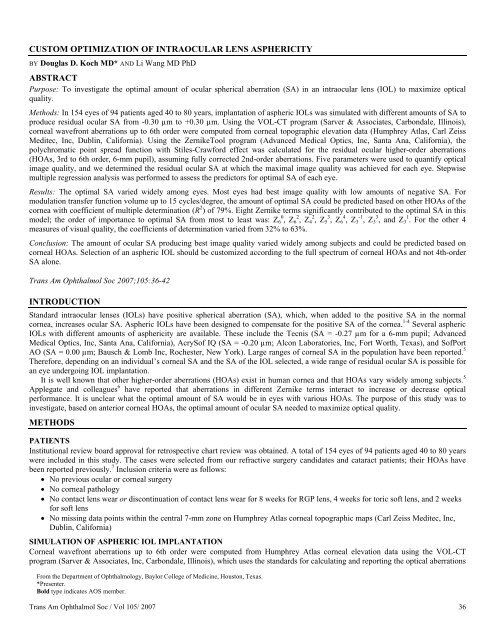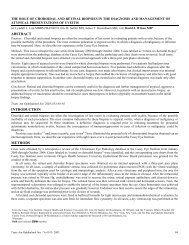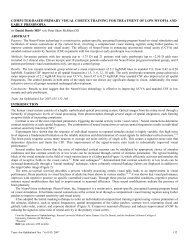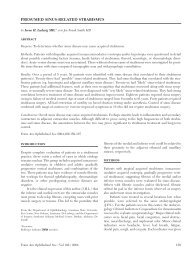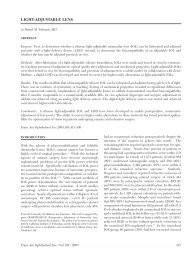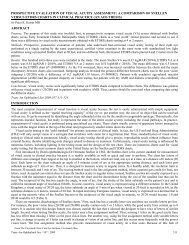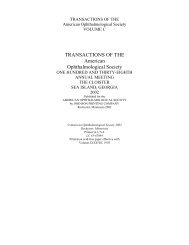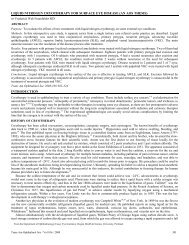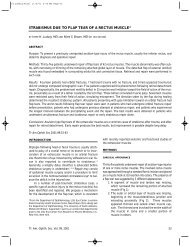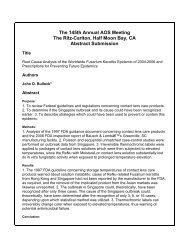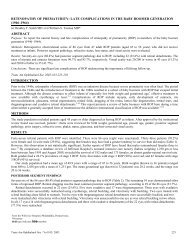Customizing Selection Of IOL Asphericity Based On Pre-Existing ...
Customizing Selection Of IOL Asphericity Based On Pre-Existing ...
Customizing Selection Of IOL Asphericity Based On Pre-Existing ...
You also want an ePaper? Increase the reach of your titles
YUMPU automatically turns print PDFs into web optimized ePapers that Google loves.
Custom Optimization <strong>Of</strong> Intraocular Lens <strong>Asphericity</strong>FIGURE 1Distribution of optimal ocular spherical aberration (SA,C 4 0 ) to produce best image quality as evaluated bymodulation transfer function volume up to 30cycles/degree. The optimal SA was rounded to thenearest SA in 0.05-µm intervals. For example, thereported optimal SA of 0 µm included values from -0.02 to +0.02 µm, and optimal SA of -0.05 µm includedvalues from -0.07 to -0.03 µm.FIGURE 2Distribution of optimal ocular spherical aberration (SA,C 4 0 ) to produce best image quality as evaluated bymodulation transfer function volume up to 15cycles/degree. The optimal SA was rounded to the nearestSA in 0.05-µm intervals. For example, the reported optimalSA of 0 µm included values from -0.02 to +0.02 µm, andoptimal SA of -0.05 µm included values from -0.07 to -0.03 µm.FIGURE 3Distribution of optimal ocular spherical aberration (SA,C 4 0 ) to produce best image quality as evaluated by Strehlratio. The optimal SA was rounded to the nearest SA in0.05-µm intervals. For example, the reported optimal SAof 0 µm included values from -0.02 to +0.02 µm, andoptimal SA of -0.05 µm included values from -0.07 to -0.03 µm.FIGURE 4Distribution of optimal ocular spherical aberration (SA,C 4 0 ) to produce best image quality as evaluated byencircled energy at 2 arc minutes. The optimal SA wasrounded to the nearest SA in 0.05-µm intervals. Forexample, the reported optimal SA of 0 µm includedvalues from -0.02 to +0.02 µm, and optimal SA of -0.05µm included values from -0.07 to -0.03 µm.Trans Am Ophthalmol Soc / Vol 105/ 2007 38
Koch, WangFIGURE 5Distribution of optimal ocular spherical aberration (SA, C 4 0 ) to produce best image quality asevaluated by encircled energy at 4 arc minutes. The optimal SA was rounded to the nearest SAin 0.05-µm intervals. For example, the reported optimal SA of 0 µm included values from -0.02to +0.02 µm, and optimal SA of -0.05 µm included values from -0.07 to -0.03 µm.DISCUSSIONThere are two primary reasons to customize the asphericity of the <strong>IOL</strong> for each eye: (1) There is a wide range of corneal SA in thepopulation. (2) As shown in this study, other higher-order corneal aberrations interact variably with SA to increase or decrease opticalperformance. HApplegateH and colleagues 6 investigated how pairs of Zernike modes interact to increase or decrease visual acuity. Theyfound that acuity varied significantly, depending on the modes that were selected and the relative contribution of each mode. Twomodes 2 radial orders apart and having the same sign and angular frequency combined to increase visual acuity, whereas 2 modeswithin the same radial order combined to decrease acuity. We are unaware of any studies investigating what the optimal amount of SAwould be in eyes with various corneal HOAs.In this study, we evaluated the optimal amount of ocular SA needed to maximize optical quality in patients in the cataract agerange (40-80 years). To account for chromatic aberrations and the Stiles-Crawford effect in the human eye, the polychromatic PSFwas calculated with Stiles-Crawford effect incorporated; the goal was to simulate the image quality a subject might experience in thewhite-light environment. Five parameters were used to quantify the optical image quality of the eye. Various metrics evaluatingoptical quality have been studied, 10-12 and controversy exists regarding which metric or combination of metrics best predicts quality ofvision.We found that most eyes did not have best image quality at SA of 0 µm and that the optimal SA varied widely among eyes. For 4of the 5 parameters that were used to predict optical image quality of the eye (MTF volume up to 30 cycles/degree, MTF volume up to15 cycles/degree, Strehl ratio, and EE at 2 arc minutes), the highest percentage of eyes had best image quality at residual ocular SA of-0.05 µm (34.4%-61.7%). With the EE at 4 arc minutes, the highest percentage of eyes had best image quality at residual ocular SA of-0.10 µm (45.5%).Using the stepwise multiple regression analysis, we found that the amount of optimal SA could be predicted based on other HOAsof the cornea with a coefficient of multiple determination (R 2 ) up to 79% for MTF volume up to 15 cycles/degree, indicating that 79%of the variation in the optimal SA is accounted for by the 8 Zernike terms included in the model. The R 2 values were 63% for MTFvolume up to 30 cycles/degree, and 32% to 37% for Strehl ratio and EE at 2 and 4 arc minutes, respectively. Among the Zernike termsthat significantly contributed to the optimal SA, 6th-order SA (Z 6 0 ) made the greatest contribution for 4 of the 5 parameters evaluatedin this study. This demonstrates aberration interactions among Zernike terms as reported by Applegate and colleagues. 6Both in the laboratory by using adaptive optics 3 and in clinical studies, aspheric <strong>IOL</strong>s have been shown to reduce ocular SAs,improve contrast sensitivity, and improve night driving performance. 2,4 However, 2 recent studies 13,14 reported no differences betweenaspheric and spherical <strong>IOL</strong>s in low-contrast visual acuity, high-contrast visual acuity, and contrast sensitivity. Although multiplefactors may contribute to these conflicting findings, lack of optimization of residual ocular SA might play a role. In the subjectsincluded in this study, the corneal 4th-order SA ranged from 0.076 μm to 0.544 μm. Assuming implantation of Tecnis lens, AcrySofIQ lens, SofPort AO lens, and standard <strong>IOL</strong> with positive SA (SA = +0.18 µm) in these eyes, the residual ocular SA would range fromTrans Am Ophthalmol Soc / Vol 105/ 2007 39
Custom Optimization <strong>Of</strong> Intraocular Lens <strong>Asphericity</strong>-0.194 to 0.274 µm, -0.124 to 0.344 µm, 0.076 to 0.544 µm, and 0.256 to 0.724 µm, respectively. This spectrum of SA data mayexplain, at least in part, variations in studies’ results.Limitations of the study included the following:1. This was a theoretical study, not a clinical study.2. We assumed that the 2nd-order aberrations (defocus and astigmatism) were fully corrected by some means, such as spectacles,following cataract surgery; the optimal SA would differ as a function of residual defocus or/and astigmatism.3. Calculations were made for a 6-mm pupil; the impact of residual SA will be less with a smaller pupil, and the optimal value foreach eye might change as pupil size changes.4. This study assumed that the aspheric <strong>IOL</strong>s were well centered and not tilted; decentration of aspheric <strong>IOL</strong>s induces coma, 7,15which may affect the amount of optimal SA for that eye.5. This study did not evaluate the effect of optimization of SA on depth of focus.6. This study ignored the neuroadaptive response. Using an adaptive optics system, Artal and colleagues 16 found that the stimulusseen with the subject’s own aberrations was always sharper than when seen through the rotated version, but that subjects werecapable of readapting to new HOAs; the magnitude and timing of this response is under study. Webster and associates 17 reportedthat neural adaptation could also profoundly affect the actual perception of image focus.In summary, the results of this study demonstrated that the optimal SA producing best image quality varied widely among subjectsand could be predicted based on other HOAs. Customization of <strong>IOL</strong> selection should be based on the full spectrum of preexistingcorneal HOAs and not on 4th-order SA alone. Further theoretical and clinical studies are desirable to address issues such asdecentration, tilt, depth of focus, and, of course, clinical assessment of quality of vision.ACKNOWLEDGMENTSFunding/Support: Supported in part by an unrestricted grant from Research to <strong>Pre</strong>vent Blindness.Financial Disclosures: Dr Koch is a consultant for Advanced Medical Optics, Inc, Alcon Surgical, Inc, and Calhoun Vision, Inc. DrWang has reported no relevant financial interests.Author Contributions: Design and conduct of the study (D.D.K., L.W.); Collection, management, analysis, and interpretation of thedata (D.D.K., L.W.); <strong>Pre</strong>paration, review, and approval of the manuscript (D.D.K., L.W.).REFERENCES1. Holladay JT, Piers PA, Koranyi G, van der Mooren M, Norrby NE. A new intraocular lens design to reduce spherical aberrationof pseudophakic eyes. J Refract Surg 2002;18:683-691.2. Packer M, Fine IH, Hoffman RS, Piers PA. Prospective randomized trial of an anterior surface modified prolate intraocular lens.J Refract Surg 2002;18:692-696.3. HPiers PA, Fernandez EJ, Manzanera S, Norrby S, Artal P.H Adaptive optics simulation of intraocular lenses with modifiedspherical aberration. Invest Ophthalmol Vis Sci 2004;45:4601-4610.4. HBellucci R, Scialdone A, Buratto L, et al.H Visual acuity and contrast sensitivity comparison between Tecnis and AcrySofSA60AT intraocular lenses: a multicenter randomized study. J Cataract Refract Surg 2005;31:712-717.5. HWang L, Dai E, Koch DD, Nathoo A.H Optical aberrations of the human anterior cornea. J Cataract Refract Surg 2003;29:1514-1521.6. HApplegate RA, Marsack JD, Ramos R, Sarver EJ.H Interaction between aberrations to improve or reduce visual performance. JCataract Refract Surg 2003;29:1487-1495.7. HWang L, Koch DD.H Effect of decentration of wavefront-corrected intraocular lenses on the higher-order aberrations of the eye.Arch Ophthalmol 2005;123:1226-1230.8. Thibos LN, Applegate RA, Schwiegerling JT, et al. Standards for reporting the optical aberrations of eyes. In: MacRae SM,Krueger RR, Applegate RA, eds. Customized Corneal Ablation: The Quest for SuperVision. Thorofare, NJ: Slack, Inc; 2001:348-361.9. HDai GM.H Optical surface optimization for the correction of presbyopia. Appl Opt 2006;45:4184-4195.10. HChen L, Singer B, Guirao A, Porter J, Williams DR.H Image metrics for predicting subjective image quality. Optom Vis Sci2005;82:358-369.11. HMarsack JD, Thibos LN, Applegate RA.H Metrics of optical quality derived from wave aberrations predict visual performance. JVis 2004;4:322-328.12. HApplegate RA, Marsack JD, Thibos LN.H Metrics of retinal image quality predict visual performance in eyes with 20/17 or bettervisual acuity. Optom Vis Sci 2006;83:635-640.13. HKurz S, Krummenauer F, Thieme H, Dick HB.H Contrast sensitivity after implantation of a spherical versus an asphericalintraocular lens in biaxial microincision cataract surgery. J Cataract Refract Surg 2007;33:393-400.14. HKasper T, Buhren J, Kohnen T.H Visual performance of aspherical and spherical intraocular lenses: intraindividual comparison ofvisual acuity, contrast sensitivity, and higher-order aberrations. J Cataract Refract Surg 2006;32:2022-2029.Trans Am Ophthalmol Soc / Vol 105/ 2007 40
Koch, Wang15. HAltmann GE, Nichamin LD, Lane SS, Pepose JS.H Optical performance of 3 intraocular lens designs in the presence ofdecentration. J Cataract Refract Surg 2005;31:574-585.16. HArtal P, Chen L, Fernandez EJ, Singer B, Manzanera S, Williams DR.H Neural compensation for the eye’s optical aberrations. JVis 2004;4:281-287.17. HWebster MA, Georgeson MA, Webster SM.H Neural adjustments to image blur. Nat Neurosci 2002;5:839-840.PEER DISCUSSIONDR HENRY GELENDER: The investigation and understanding of the wavefront aberrations of the eye has been applied to refractivecorneal surgery, such as LASIK and PRK. As a result, customized refractive surgery now affords improved visual outcomes for theserefractive procedures. Now these same principles are being applied to implant technology and cataract surgery. The authors, in apreviously published article titled “Optical Aberrations of the Human Anterior Cornea,” have shown that anterior corneal wavefrontaberrations vary among subjects and increase with age. 1 Moreover, they have shown that all corneas studied had positive Zernike 4thorderspherical aberrations (SAs). In this study, the authors continue their investigations using a theoretical model for studying theoptimal amount of SA, which when applied to an intraocular lens would maximize the optical quality following cataract surgery.They found that the optimal SA producing best image quality varied widely among subjects. Additionally, they found that multipleZernike terms contributed to the optimal SA. From their studies they conclude that the full spectrum of corneal higher-orderaberrations (HOAs) should be considered and not just the 4th-order SA.Aspheric intraocular lenses have been developed, whereby the aspheric design of the implant can offset the SA of the cornea,attempting to mimic the crystalline lens of youth for improved image quality. However, current aspheric implants are available in astandard “one size fits all” approach. As the authors imply from their study, customized implants would need to be produced tocompensate a variety of corneal HOAs. This begs the question, Is this practical for implant manufacturers? It has also been shownthat the resultant wavefront aberrations after cataract surgery are affected by implant decentration, tilt, and rotation as well as theeffect of corneal incision size, location, and wound healing. 2 These factors, which may only be assessed postoperatively, may offsetthe benefit of wavefront modified implants, which have been selected on the basis of preoperative corneal HOA. Ultimately,customized corneal refractive surgery may be used following the cataract surgery to correct the induced or residual optical aberrationsof the eye. This could be additive to the benefits of customized, HOA-correcting implants. Also intriguing is the possibility of usinglight-adjustable lenses, which can be treated postoperatively to correct the residual HOAs. This technique was reported at last year’sAOS meeting. 3The authors rightfully point out that their study is limited as a theoretical study. Clinical studies are necessary to assess the effectof optical aberrations on image quality after cataract surgery. The authors are to be congratulated for the design and execution of theirstudy. The information reported is incremental to our understanding of the complex nature of how aberrations of the eye affect visualoutcomes from cataract surgery.ACKNOWLEDGMENTSFunding/Support: NoneFinancial Disclosures: None.REFERENCES1. Wang L, Dai E, Koch DD, Nathoo A. Optical aberration of the human anterior cornea. J Cataract Refract Surg 2003;29:1514-1521.2. Wang L, Koch DD. Effect of decentration of wavefront-corrected intraocular lenses on the higher-order aberrations of the eye.Arch Ophthalmol 2005;123:1226-1230.3. Sandstedt CA, Chang SH, Grubbs RH, Schwartz DM. Light-adjustable lens: customizing correction for multifocality andhigher-order aberrations. Trans Am Ophthalmol Soc 2006;104:29-39.DR. ROBERT C. DREWS: No commercial interest. With sincere respect, and I mean that Doug, how many of your postoperativecataracts patients had 6 mm pupils, and what happens to the importance of the spherical aberrations with a 2.5 mm pupil?DR. DOUGLAS R. ANDERSON: No conflicts that pertain to this presentation. My question is very similar, but it has another twist toit. That is, the size of the pupil does matter, and it determines how much of the cornea is being used. We are talking about thespherical aberration of the entire cornea including the periphery in studying the higher-order aberrations particularly. In addition tothat, the fovea is the only place or the main place where a crisp image makes a difference for the ability to see and, in particular, thefovea uses only a central circle of the cornea. I wonder whether it makes any sense to measure these higher-order aberrations over theentire cornea, but perhaps over just the central 4 or 5 mm of the cornea, which is the area contributing light toward fovea.DR. GEORGE O. WARING, III: Consultant for American Medical Optics and Calhoun Vision. We are hearing a lot aboutaccommodative intraocular lenses. Could you comment on that since yours is a theoretical study on the possible impact ofaccommodative <strong>IOL</strong>s with the higher-order aberrations?DR. GEORGE L. SPAETH: Doug that is fascinating. It is a fact that people who are missing parts of their visual field fill those in sothat they function very well. There is little correlation between the amount of visual field loss and the actual disability because ofcortical plasticity. Some people seem to be able to do that much better than others. Some people tolerate the accommodative lensesTrans Am Ophthalmol Soc / Vol 105/ 2007 41
Custom Optimization <strong>Of</strong> Intraocular Lens <strong>Asphericity</strong>better than others. Are you or others working on trying to figure out why it is that some people can handle that sort of visual problemmore successfully than others?DR. DOUGLAS D. KOCH: I would like to thank everyone for their very interesting and relevant comments. Dr. Gelender’s pointabout postoperative modification is intriguing and is an area of intense investigation. We heard last year about the Calhoun lens,which offers the possibility of modifying the power and aberrations of an intraocular lens postoperatively. In the Calhoun clinicaltrial, spherical aberration was corrected in a patient after cataract surgery by irradiating the lens. The comments of Drs. Drews andAnderson on pupil size are important. Clearly, the data I have presented represent the worse case scenario of a 6 mm pupil. Theimpact of the aberrations diminishes as pupil size diminishes. <strong>On</strong> the other hand, we are doing more and more lens surgery on youngpeople in their forties and fifties who have large pupils. They easily dilate to 6 mm and larger at night, so it is highly relevant for them.Dr. Waring inquires about quality of vision with accommodating <strong>IOL</strong>s. I presented a paper on this subject at the recent ASCRSmeeting. There are data to suggest that decentration and tilt are not a major problem, but there is a more work to be done on this issue.Dr. Spaeth asked if we can predict which patients can adapt to which <strong>IOL</strong>s. There are two relevant categories to consider, the first ofwhich is multifocal <strong>IOL</strong>s. I think most clinicians today who are using these <strong>IOL</strong>s still find it to be a conundrum to select patients whouniformly either will or will not like these lenses. I find it a matter of great frustration in my practice. This suggests that patienthistories and patient personality profiles are not the whole picture. I believe that unknown factors at the level of retinal or CNS neuralprocessing are involved. The second area is monovision, which is more predictable but again is subject to some variability inpatients’ ability to adapt to and accept it. <strong>On</strong>e of our new inductees, Dan Durrie, did a very nice thesis on the issue of adaptation tomonovision, and we are learning more about that as well.Trans Am Ophthalmol Soc / Vol 105/ 2007 42


